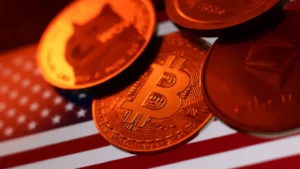US stablecoin rules deposit outflows — the fight over a “yield” loophole

What changed: the GENIUS Act
In July, Congress passed the Guiding and Establishing National Innovation for US Stablecoins (GENIUS) Act, the first federal framework for “payment stablecoins.” It requires high-quality reserves and permits banks to issue coins, but it prohibits issuers from paying interest or yield to holders. The law does not explicitly bar affiliates like exchanges from offering rewards tied to third-party coins—setting up today’s clash over US stablecoin rules deposit outflows.
Why banks are alarmed
- Uneven playing field: Banks can issue coins but can’t pay yield; exchanges could still offer rewards on coins like USDC or USDT.
- Deposit flight risk: Trade groups warn that if rewards persist, consumers could shift cash from deposits into yield-bearing stablecoins—potentially accelerating US stablecoin rules deposit outflows during stress.
- Credit transmission: Fewer deposits may lift bank funding costs, resulting in higher loan rates and tighter credit for households and small businesses.
The “interest loophole,” explained
The Act bans issuer-paid interest, but some exchanges and partners can structure rewards for holding third-party stablecoins (staking-like programs, fee-share, or promotional APRs). Bank groups want Congress to extend the prohibition to exchanges and affiliates, arguing this closes the gap, fueling US stablecoin rules deposit outflows.
What crypto says
Crypto trade associations counter that payment stablecoins aren’t bank deposits or investment products, and that banning exchange rewards would entrench banks and reduce competition. They argue consumer choice—especially for digital dollars used globally—shouldn’t be curbed to avoid hypothetical US stablecoin rules deposit outflows.
Macro angle: Treasuries demand vs. banking system impact
Because leading stablecoins hold large T-bill reserves, a growing market could deepen demand for short-term U.S. debt—even as banks warn about US stablecoin rules deposit outflows from the traditional system. Policymakers are weighing these trade-offs: more efficient dollar rails and Treasury demand on one side, potential pressure on bank funding and credit creation on the other.
Trading angles
- Bank funding spreads: Headlines about amendments or hearings may widen/normalize NIM expectations and short-tenor funding spreads.
- Exchange-exposed equities: Names tied to stablecoin rewards could react to any move to restrict exchange-level yield programs.
- T-bill complex: Sustained stablecoin growth supports incremental bill demand; watch auction tails and bill/OIS basis for signals.
- Event path: Track draft amendments, committee calendars, and Treasury guidance—each a possible catalyst.
Bottom line
This fight isn’t just about who can pay “yield.” It’s about the future mix of deposits versus digital dollars—and whether policy prioritizes banking intermediation or open competition in dollar payments. As Congress weighs fixes, the trajectory of US stablecoin rules deposit outflows will hinge on how (and if) the interest prohibition is extended to exchanges and affiliates.
